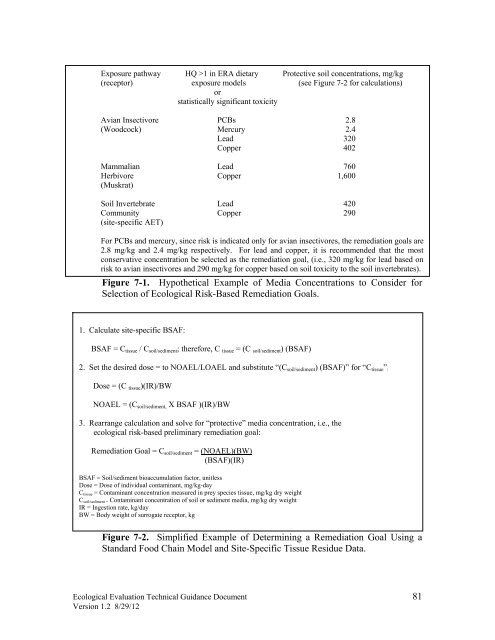Ecological Evaluation Technical Guidance - State of New Jersey
Ecological Evaluation Technical Guidance - State of New Jersey
Ecological Evaluation Technical Guidance - State of New Jersey
- No tags were found...
Create successful ePaper yourself
Turn your PDF publications into a flip-book with our unique Google optimized e-Paper software.
Exposure pathway HQ >1 in ERA dietary Protective soil concentrations, mg/kg(receptor) exposure models (see Figure 7-2 for calculations)orstatistically significant toxicityAvian Insectivore PCBs 2.8(Woodcock) Mercury 2.4Lead 320Copper 402Mammalian Lead 760Herbivore Copper 1,600(Muskrat)Soil Invertebrate Lead 420Community Copper 290(site-specific AET)For PCBs and mercury, since risk is indicated only for avian insectivores, the remediation goals are2.8 mg/kg and 2.4 mg/kg respectively. For lead and copper, it is recommended that the mostconservative concentration be selected as the remediation goal, (i.e., 320 mg/kg for lead based onrisk to avian insectivores and 290 mg/kg for copper based on soil toxicity to the soil invertebrates).Figure 7-1. Hypothetical Example <strong>of</strong> Media Concentrations to Consider forSelection <strong>of</strong> <strong>Ecological</strong> Risk-Based Remediation Goals.1. Calculate site-specific BSAF:BSAF = C tissue / C soil/sediment ; therefore, C tissue = (C soil/sediment ) (BSAF)2. Set the desired dose = to NOAEL/LOAEL and substitute “(C soil/sediment ) (BSAF)” for “C tissue ” :Dose = (C tissue )(IR)/BWNOAEL = (C soil/sediment, X BSAF )(IR)/BW3. Rearrange calculation and solve for “protective” media concentration, i.e., theecological risk-based preliminary remediation goal:Remediation Goal = C soil/sediment = (NOAEL)(BW)(BSAF)(IR)BSAF = Soil/sediment bioaccumulation factor, unitlessDose = Dose <strong>of</strong> individual contaminant, mg/kg-dayC tissue = Contaminant concentration measured in prey species tissue, mg/kg dry weightC soil/sediment = Contaminant concentration <strong>of</strong> soil or sediment media, mg/kg dry weightIR = Ingestion rate, kg/dayBW = Body weight <strong>of</strong> surrogate receptor, kgFigure 7-2. Simplified Example <strong>of</strong> Determining a Remediation Goal Using aStandard Food Chain Model and Site-Specific Tissue Residue Data.<strong>Ecological</strong> <strong>Evaluation</strong> <strong>Technical</strong> <strong>Guidance</strong> Document 81Version 1.2 8/29/12
















